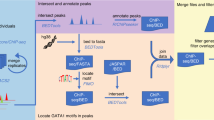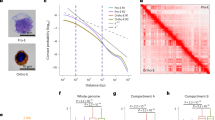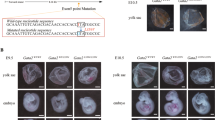Abstract
GATA-1 is a hematopoietic transcription factor that is essential for the terminal maturation of proerythroblasts, megakaryocytic cells and mast cells. The erythroid-specific promoter of the human GATA-1 gene directs the high expression of a reporter gene in K562 cells. Multiple putative transcription factor binding sites were identified in the promoter from the −860 to the −1 base pair (bp). For a better understanding of the transcriptional control of human GATA-1 gene expression, we tested the transcriptional activity of a series of deletions from the 5′ end of the 860-bp promoter. A region between −221 and −128 bp retains most of the transcriptional activity of the full-length promoter. Deletion of the CGCCC box at −195 bp reduced reporter gene activity to 60.4%. Further deletion of the CACCC box at −173 bp nearly abolished reporter gene expression, indicating that the CACCC box is more critical. In vitro experiments of electrophoretic mobility shifts and in vivo studies using chromatin immuno-precipitation (ChIP) assays show that the Sp1/Sp3 proteins bind the CACCC site in the nuclei of K562 cells. Coincidently, hyperacetylation of histones in the GATA-1 erythroid promoter was also shown by ChIP assay. Co-transfection of Sp1 expression plasmids and plasmids with a wild-type promoter showed enhanced reporter gene activity in a dose-dependent manner. The combined data demonstrate that Sp1/Sp3, but not EKLF, is involved in the activation of the GATA-1 erythroid promoter, and that histones H3 and H4 are highly acetylated in this promoter region for an actively transcribed GATA-1 gene in K562 cells in which EKLF is barely detectable.
Similar content being viewed by others
Log in or create a free account to read this content
Gain free access to this article, as well as selected content from this journal and more on nature.com
or
Abbreviations
- (bp):
-
base pair
- (ds):
-
double-stranded
- (EKLF):
-
erythroid Krüppel-like factor
- (EMSA):
-
electrophoretic mobility shift assay
- (ChIP):
-
chromatin immuno-precipitation assay
References
Weiss MJ, Orkin SH . GATA transcription factors: key regulators of hematopoiesis. Exp Hematol 1995; 23:99–107.
Martin DI, Zon LI, Mutter G, Orkin SH . Expression of an erythroid transcription factor in megakaryocytic and mast cell lineages. Nature 1990; 344:444–447.
Tsai SF, Martin DI, Zon LI, D'Andrea AD, Wong GG, Orkin SH . Cloning of cDNA for the major DNA-binding protein of the erythroid lineage through expression in mammalian cells. Nature 1989; 339:446–451.
Zon LI, Yamaguchi Y, Yee K, et al. Expression of mRNA for the GATA-binding proteins in human eosinophils and basophils: potential role in gene transcription. Blood 1993; 81:3234–3241.
Weiss MJ, Keller G, Orkin SH . Novel insights into erythroid development revealed through in vitro differentiation of GATA-1 embryonic stem cells. Genes Dev 1994; 8:1184–1197.
Fujiwara Y, Browne CP, Cunniff K, Goff SC, Orkin SH . Arrested development of embryonic red cell precursors in mouse embryos lacking transcription factor GATA-1. Proc Natl Acad Sci USA 1996; 93:12355–12358.
Pevny L, Lin CS, D'Agati V, Simon MC, Orkin SH, Costantini F . Development of hematopoietic cells lacking transcription factor GATA-1. Development 1995; 121:163–172.
Shivdasani RA, Fujiwara Y, McDevitt MA, Orkin SH . A lineage-selective knockout establishes the critical role of transcription factor GATA-1 in megakaryocyte growth and platelet development. EMBO J 1997; 16:3965–3973.
Ito E, Toki T, Ishihara H, et al. Erythroid transcription factor GATA-1 is abundantly transcribed in mouse testis. Nature 1993; 362:466–468.
Hannon R, Evans T, Felsenfeld G, Gould H . Structure and promoter activity of the gene for the erythroid transcription factor GATA-1. Proc Natl Acad Sci USA 1991; 88:3004–3008.
Schwartzbauer G, Schlesinger K, Evans T . Interaction of the erythroid transcription factor cGATA-1 with a critical auto-regulatory element. Nucleic Acids Res 1992; 20:4429–4436.
Tsai SF, Strauss E, Orkin SH . Functional analysis and in vivo footprinting implicate the erythroid transcription factor GATA-1 as a positive regulator of its own promoter. Genes Dev 1991; 5:919–931.
McDevitt MA, Fujiwara Y, Shivdasani RA, Orkin SH . An upstream, DNase I hypersensitive region of the hematopoietic-expressed transcription factor GATA-1 gene confers developmental specificity in transgenic mice. Proc Natl Acad Sci USA 1997; 94:7976–7981.
Nicolis S, Bertini C, Ronchi A, et al. An erythroid specific enhancer upstream to the gene encoding the cell-type specific transcription factor GATA-1. Nucleic Acids Res 1991; 19:5285–5291.
Yu C, Cantor AB, Yang H, et al. Targeted deletion of a high-affinity GATA-binding site in the GATA-1 promoter leads to selective loss of the eosinophil lineage in vivo. J Exp Med 2002; 195:1387–1395.
Ohneda K, Shimizu R, Nishimura S, et al. A minigene containing four discrete cis elements recapitulates GATA-1 gene expression in vivo. Genes Cells 2002; 7:1243–1254.
Burch JB . Regulation of GATA gene expression during vertebrate development. Semin Cell Dev Biol 2005; 16:71–81.
Long Q, Meng A, Wang H, Jessen JR, Farrell MJ, Lin S . GATA-1 expression pattern can be recapitulated in living transgenic zebrafish using GFP reporter gene. Development 1997; 124:4105–4111.
Orkin SH . Transcription factors and hematopoietic development. J Biol Chem 1995; 270:4955–4958.
Shivdasani RA, Orkin SH . The transcriptional control of hematopoiesis. Blood 1996; 87:4025–4039.
Meng A, Tang H, Yuan B, Ong BA, Long Q, Lin S . Positive and negative cis-acting elements are required for hematopoietic expression of zebrafish GATA-1. Blood 1999; 93:500–508.
Nuez B, Michalovich D, Bygrave A, Ploemacher R, Grosveld F . Defective haematopoiesis in fetal liver resulting from inactivation of the EKLF gene. Nature 1995; 375:316–318.
Bieker JJ . Isolation, genomic structure, and expression of human erythroid Kruppel-like factor (EKLF). DNA Cell Biol 1996; 15:347–352.
Pilon AM, Nilson DG, Zhou D, et al. Alterations in expression and chromatin configuration of the alpha hemoglobin-stabilizing protein gene in erythroid Kruppel-like factor-deficient mice. Mol Cell Biol 2006; 26:4368–4377.
Gregory RC, Taxman DJ, Seshasayee D, Kensinger MH, Bieker JJ, Wojchowski DM . Functional interaction of GATA1 with erythroid Kruppel-like factor and Sp1 at defined erythroid promoters. Blood 1996; 87:1793–1801.
Merika M, Orkin SH . Functional synergy and physical interactions of the erythroid transcription factor GATA-1 with the Kruppel family proteins Sp1 and EKLF. Mol Cell Biol 1995; 15:2437–2447.
Letting DL, Rakowski C, Weiss MJ, Blobel GA . Formation of a tissue-specific histone acetylation pattern by the hematopoietic transcription factor GATA-1. Mol Cell Biol 2003; 23:1334–1340.
Owen GI, Richer JK, Tung L, Takimoto G, Horwitz KB . Progesterone regulates transcription of the p21(WAF1) cyclin-dependent kinase inhibitor gene through Sp1 and CBP/p300. J Biol Chem 1998; 273:10696–10701.
Wingender E, Chen X, Hehl R, et al. TRANSFAC: an integrated system for gene expression regulation. Nucleic Acids Res 2000; 28:316–319.
Dignam JD, Lebovitz RM, Roeder RG . Accurate transcription initiation by RNA polymerase II in a soluble extract from isolated mammalian nuclei. Nucleic Acids Res 1983; 11:1475–1489.
Zhu H, Gao W, Jiang H, et al. Regulation of acetylcholinesterase expression by calcium signaling during calcium ionophore A23187- and thapsigargin-induced apoptosis. Int J Biochem Cell Biol 2007; 39:93–108.
Acknowledgements
We thank Dr Jingde Zhu (Shanghai Cancer Institute, China) for kindly providing antibody against Sp1, Sp1 expression plasmid and pcDNA3.1 vector. This work was supported in part by National Natural Science Foundation of China (Grants 30570920 and 30623003), the third phase creative program of the Chinese Academy of Sciences (KSCX1-YW-R-13), National Basic Research Program of China (2007CB947901), and the Science and Technology Commission of Shanghai Municipality (06JC14076, 06DZ22032).
Author information
Authors and Affiliations
Corresponding authors
Rights and permissions
About this article
Cite this article
Hou, C., Huang, J., He, Q. et al. Involvement of Sp1/Sp3 in the activation of the GATA-1 erythroid promoter in K562 cells. Cell Res 18, 302–310 (2008). https://doi.org/10.1038/cr.2008.10
Received:
Revised:
Accepted:
Published:
Issue date:
DOI: https://doi.org/10.1038/cr.2008.10



